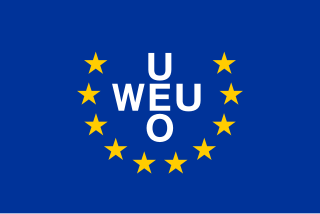
The Western European Union was the international organisation and military alliance that succeeded the Western Union (WU) after the 1954 amendment of the 1948 Treaty of Brussels. The WEU implemented the Modified Brussels Treaty. During the Cold War, the Western Bloc included the WEU member-states, plus the United States and Canada, as part of the North Atlantic Treaty Organization (NATO).
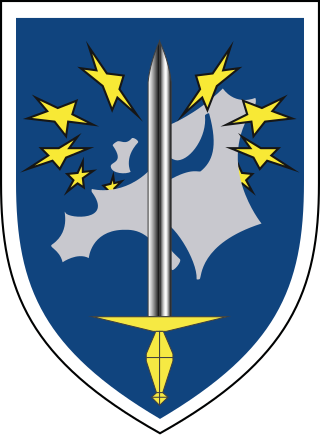
Eurocorps, located in the French city of Strasbourg (Bas-Rhin), is a multinational corps headquarters. Founded by France and Germany in 1992, it is today composed of personnel from six framework nations and five associated nations. The framework nations place the Eurocorps at the service of the European Union (EU) and NATO, which certified it in 2002 as one of its nine High Readiness Land Headquarters.

The Scandinavian defence union was a historical idea to establish a military alliance between Sweden, Norway, Finland and Denmark after the end of World War II, but the idea did not come about when Denmark, Iceland and Norway joined NATO in 1949 at the request of the United States, while Finland and Sweden did not.
Swedish neutrality refers to Sweden's former policy of neutrality in armed conflicts, which was in effect from the early 19th century to 2009, when Sweden entered into various mutual defence treaties with the European Union (EU), and other Nordic countries. Sweden's previous neutrality policy had originated largely as a result of Sweden's involvement in the Napoleonic Wars during which over a third of the country's territory was lost in the Finnish War (1808–1809), including the traumatic loss of Finland to Russia. From this point onwards, Finland remained a part of Russia until it gained independence in 1917. Resentment towards the Swedish king Gustav IV Adolf who had consistently pursued an anti-napoleonic policy and thereby caused the war, precipitated a coup d'état known as the Coup of 1809. The new regime deposed the king and introduced the Instrument of Government (1809), later formulating a new foreign policy which became known as The Policy of 1812.

The Common Security and Defence Policy (CSDP) is the European Union's (EU) course of action in the fields of defence and crisis management, and a main component of the EU's Common Foreign and Security Policy (CFSP).
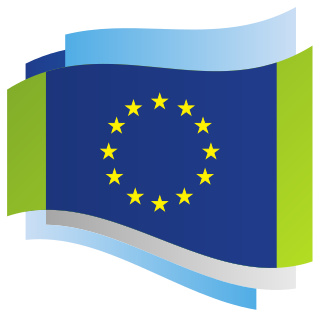
The European Defence Agency (EDA) is an agency of the European Union (EU) that promotes and facilitates integration between member states within the EU's Common Security and Defence Policy (CSDP). The EDA is headed by the EU High Representative for Foreign Affairs and Security Policy, European Commission’s Vice President (HR/VP), and reports to the Council. The EDA was established on 12 July 2004 and is based in Brussels, Belgium, along with a number of other CSDP bodies.

In the European Union (EU), enhanced cooperation is a procedure where a minimum of nine EU member states are allowed to establish advanced integration or cooperation in an area within EU structures but without the other members being involved. As of October 2017, this procedure is being used in the fields of the Schengen acquis, divorce law, patents, property regimes of international couples, and European Public Prosecutor and is approved for the field of a financial transaction tax.

The Western Union (WU), also referred to as the Brussels Treaty Organisation (BTO), was the European military alliance established between France, the United Kingdom (UK) and the three Benelux countries in September 1948 in order to implement the Treaty of Brussels signed in March the same year. Under this treaty the signatories, referred to as the five powers, agreed to collaborate in the defence field as well as in the political, economic and cultural fields.

The Lancaster House Treaties of 2010 are two treaties between the United Kingdom and France for defence and security cooperation. They were signed at 10 Downing Street on 2 November 2010 by British prime minister David Cameron and French President Nicolas Sarkozy.
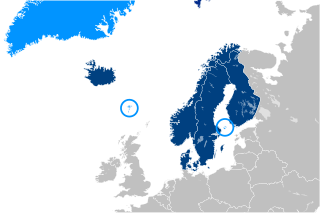
The Nordic Defence Cooperation (Nordefco) is a collaboration among the Nordic countries in the area of defense. Its five members are Denmark, Finland, Iceland, Norway, and Sweden.
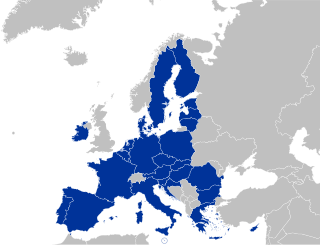
The Permanent Structured Cooperation (PESCO) is the part of the European Union's (EU) security and defence policy (CSDP) in which 26 of the 27 national armed forces pursue structural integration. Based on Article 42.6 and Protocol 10 of the Treaty on European Union, introduced by the Treaty of Lisbon in 2009, PESCO was first initiated in 2017. The initial integration within the PESCO format is a number of projects which launched in 2018.

The Joint Expeditionary Force (JEF) is a United Kingdom-led Northern European international expeditionary force which consists of the Nordic countries, the Baltic states, and the Netherlands. Nine of its ten member states are also members of NATO, with Sweden currently outside that alliance as their application is pending ratification.

Military Mobility is one of the initial projects launched under the European Union's (EU) Permanent Structured Cooperation in Defence (PESCO) facility. It is commonly termed a "Military Schengen" as it is inspired by the EU's Schengen Area, but designated to aid the free movement of military units and assets throughout Europe via removal of bureaucratic barriers and improvement of infrastructure.

The Crisis Response Operation Core (CROC) is a flagship European Union defence project under development as part of Permanent Structured Cooperation (PESCO). CROC will contribute to the creation of a "full spectrum force package" to speed up provision of military forces and the EU's crisis management capabilities.

This article outlines the history of the Common Security and Defence Policy (CSDP) of the European Union (EU), a part of the Common Foreign and Security Policy (CFSP).

This article outlines the defence forces of the European Union (EU), which implement the EU's Common Security and Defence Policy (CSDP) in CSDP missions. There are two categories of EU multinational forces: ones that have been established intergovernmentally and made available to the CSDP through article 42.3 of the Treaty on European Union (TEU), such as the Eurocorps; and the EU Battlegroups, established at the EU level.
The European Personnel Recovery Centre (EPRC) is an intergovernmental military organisation that contributes to the development and harmonisation of policies and standards related to personnel recovery. The ERPC also provides support for education, training, exercises and operations. The EPRC was established on 8 July 2015 and is based at Poggio Renatico Air Base in Italy.
The Joint European Union Intelligence School (JEIS) is a project of the Permanent Structured Cooperation (PESCO) that was announced in November 2018. The project will be led by Cyprus and Greece. The school will provide education and training in intelligence disciplines, among other things, to EU member states intelligence personnel, and develop new hardware, including drones and electronic warfare technology.

This article outlines the present structure of the European Union's Common Security and Defence Policy (CSDP), a part of the Common Foreign and Security Policy (CFSP) based on articles 42–46 of the Treaty on European Union (TEU). Article 42.2 of TEU states that the CSDP includes the 'progressive framing' of a common Union defence policy, and will lead to a common defence, when the European Council of national heads of state or government, acting unanimously, so decides.

The European Union (EU) and the North Atlantic Treaty Organisation (NATO) are two main treaty-based Western organisations for cooperation between member states, both headquartered in Brussels, Belgium. Their natures are different and they operate in different spheres: NATO is a purely intergovernmental organisation functioning as a military alliance, which serves to implement article 5 of the North Atlantic Treaty on collective territorial defence. The EU on the other hand is a partly supranational and partly intergovernmental sui generis entity akin to a confederation that entails wider economic and political integration. Unlike NATO, the EU pursues a foreign policy in its own right—based on consensus, and member states have equipped it with tools in the field of defence and crisis management; the Common Security and Defence Policy (CSDP) structure.














